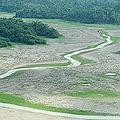 根據巴西環境部長指出,在這第二年的檢測當中,亞馬遜地區的森林消退速率已減緩,相較於2005年減少了11%,這項成果令巴西官員相信,更嚴苛地取締非法濫伐將有所成效。初步統計,從2005年8月到2006年8月,合法和非法森林砍伐面積共計6,450平方英里(正式官方報告年底發布)。前一年同期砍伐面積是7,255平方英里。
根據巴西環境部長指出,在這第二年的檢測當中,亞馬遜地區的森林消退速率已減緩,相較於2005年減少了11%,這項成果令巴西官員相信,更嚴苛地取締非法濫伐將有所成效。初步統計,從2005年8月到2006年8月,合法和非法森林砍伐面積共計6,450平方英里(正式官方報告年底發布)。前一年同期砍伐面積是7,255平方英里。
在5日的記者會上,巴西環境部長席爾娃(Marina Silva)強調,「這並非僅是循環性衰退。」而環境學者對此消退速率持審慎樂觀態度。
世界自然基金會(WWF)巴西執行長哈姆(Denise Hamú)表示:「砍伐面積降低當然是件好事,但巴西雨林的情況尚未脫離困境。官方必須整合出更具體的保育和開發政策,以確實遏止森林非法濫伐;並提出鼓勵政策推動當地永續性森林經濟活動。」
森林消退速率減緩的因素不一而足,黃豆價格下跌是其中之一。黃豆產銷是巴西重要的經濟產業,然而上週豆價跌到兩年來新低點;以往居高不下的豆價是誘使巴西人砍伐森林改種黃豆的一大吸引力。
另一份6日發佈的報告指出,過去養牛場和小型耕作業造成亞馬遜雨林區濫伐的景況,可能改由大規模農業取代;報告特別針對馬扥格羅索(Mato Grosso)為研究對象,因為該行政區自2001年起,就是巴西森林砍伐和黃豆種植速率最快的一州。
研究團隊結合砍伐地理圖、田野調查和衛星資訊,觀察60英畝以上的大片雨林區被砍伐後的後續發展;森林砍伐之後除了作為農地和養牛場,有時也會在數年後看到森林復育。
研究中發現,森林遭砍伐淪為農地的面積大小,和當年黃豆價格有直接關聯;因此,一旦國際市場黃豆價格回升,森林消退速率恐怕將再攀升到2003到2004年的高峰。
For the second year in row the pace of deforestation in the Amazon rainforest has declined, according to estimates released this week by Brazil's environment minister. Deforestation rates fell 11 percent from last year, giving Brazilian authorities hope that tougher enforcement of illegal logging may be working.
The preliminary figures show that 6,450 square miles of forest were cut legally and illegally from August 2005 to August 2006 - the official report will be released by the end of the year. Some 7,255 square miles were cleared in the preceding year.
"This shows it wasn't just a cyclical reduction," Brazil's Environment Minister Marina Silva told reporters a news conference Tuesday. Environmentalists greeted the news with cautious optimism.
"The decline is encouraging, but we are not out of the woods yet," said WWF-Brazil's CEO Denise Hamú. "More concerted action is required to integrate the government's environmental and development policies in order to really crack down on illegal activities that are having an adverse effect on the forest. Encouraging policies that foster a sustainable forestry-based regional economy should be pursued."
A number of factors help explain the declining deforestation rate, including a reduction in the price of soy - Brazil's most important agriculture commodity. Soy prices reached a two-year low late last week. Higher soy prices have in the past created incentives to clear the forest to make way for new plantations.
But a new study released Wednesday shows that deforestation in the Amazon may be shifting from cattle ranching and small-plot farming to large-scale agriculture. The study focused on Mato Grosso, the Brazilian state with the highest rate of both deforestation and soybean production since 2001.
The research team combined deforestation maps, field surveys and satellite-based information to determine what happened to large plots - greater than 60 acres - of rainforest after they were cleared. Clear areas were characterized as cropland, cattle pasture, or re-growing forest in the years following initial clearing.
The study found that the area deforested for cropland and the mean annual soybean price in the year of forest clearing were directly correlated, suggesting that deforestation rates could return to higher levels seen in 2003-2004 with a rebound of crop prices in international markets.






